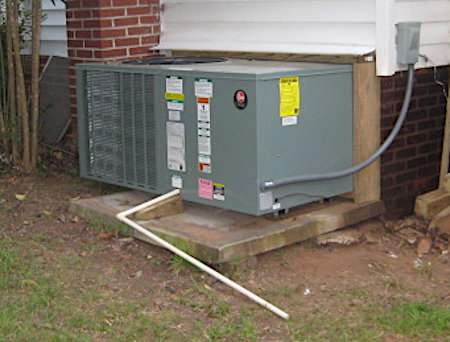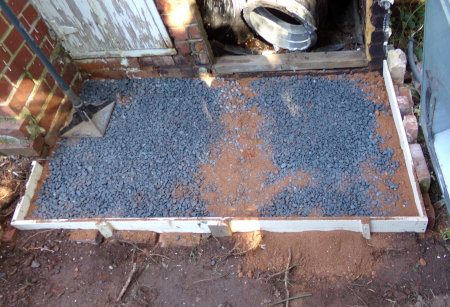Here it is. My annual self-promotion post, hopefully in time for folks looking for
economical ways to check family and friends off their gift-giving list. Given
the way things are these days, the book I'd like to feature this year is one that's relevant in days of potential economic uncertainty. That book
is
Why do I think it's relevant? Here's an excerpt from the introduction.
"This book is for those who are looking for long-term preparedness that
goes beyond simply stocking up on canned foods, dry goods, and other
necessities. Gardening adds fresh vegetables and fruits to the diet, but
keeping farm animals will enable you to have fresh eggs, milk, butter,
cheese, and meat."
To this you might say, "but I live in an apartment, or in town, where the city
or homeowners' association forbids keeping farm animals". But consider this -
folks keep rabbits and quail in garages, basements, and spare rooms, and miniature breeds in backyards.
That still might not convince you, but if you—or someone you know—is concerned
about inflation, supply chains, and being able to feed their families, then
please consider giving this book a read. Here's a little more from the
introduction.
"Those of us who didn’t grow up farming are often puzzled about how to
begin. We lack the skills and knowledge needed to make a start. Dan and I
had to rely on research plus trial and error, but always with the question
“what if?” on our minds. What if we could no longer buy layer pellets at the
feed store? What if we could no longer buy filters for straining milk, or
cultures and rennet for making cheese? What if the grid goes down—how will
we store our eggs, milk, and meat? Some of what we tried worked, but some of
it didn’t. This book is a compilation of everything we have learned about
preparedness with livestock and how we put it into practice. Its aim is to
give you the advantage of our research and experience, so that hopefully you
can avoid some of the problems we have had."
"Prepper’s Livestock Handbook
will give you the information you need to make workable choices for your
own homestead. My goal is to give you a foundation upon which to build that
you can adjust according to your personal goals and circumstances."
Maybe rather than me telling you why you should get the book, I'll just share some excerpts, along with a sampling of some of the charts in the
book. It contains ten chapters, an extensive resource list, and is about 230 pages long.
Chapter 1, "First Things First"
"People keep livestock for many reasons: eggs, dairy, meat, vegetation
control, manure for compost, to sell, as pets, for showing, for breed
conservation, because they like a particular animal, or any combination of
these. Your reasons for keeping farm animals will determine your livestock
philosophy and methods, as will your location and terrain."
"Probably the most common questions are “How much land do I need?” and
“How many animals can I keep on my property?” Called “stocking rates,” the
answers to those questions are often unsatisfying, because they depend not
only on the amount of land but on the quality of forage, as well as the
kinds of animals you want to keep. I will give you a better idea on that
in the next chapter, Best Breeds for Self-Reliance."
Chapter 2, "Best Breeds for Self-Reliance"
"Most of the livestock breeds that people are familiar with are commercial
breeds. These are the animals we see on farms in the movies and in
children’s picture books. They are the most common breeds because
industrialized agriculture is the most extensive form of farming practiced
in the modern world. Commercial producers are looking for cost
effectiveness: maximum output (profit) on the most economical inputs
(expenses) possible. The breeds they use have been developed to increase
production and weight gain on scientifically formulated feeds with the
ability to tolerate overcrowding in confined spaces. Breeding and mothering
instincts are considered nonessential and often bred out. Some commercial
breeds of chickens and turkeys, for example, don’t know how to mate and
don’t know how to hatch their eggs. Artificial insemination is used instead.
For the homesteader, there are other options."

|
|
Sample of one of the charts in chapter 2. Click to biggify.
|
Chapter 3, "Barns, Shelters, and Fencing"
"When Dan and I started preparing for livestock, we wondered if one of
our two small outbuildings would be adequate shelter for chickens and
goats. We made several modifications on what became our first “barn.” We
learned a lot from that setup and from the animals too. We made a number
of changes over the years, and when we finally built a chicken coop and a
goat barn, we were able to build structures that met both their needs and
ours."
"In the following pages, I’ll discuss basic livestock housing along with
a few ideas to help you design shelter to meet your goals and needs. I’ll
share fencing options with you, including the things we wish we’d known
before we started on ours."
Chapter 4, "Forage and Feed"
"Livestock feeding has become extremely modernized over the years. On the
one hand, this is convenient. We can simply load our pickup trucks with
50-pound bags of nutritionally complete packaged feed (called concentrates)
and an occasional sack of minerals—what could be easier? From a preparedness
perspective, however, this approach means I must purchase and store as much
hay and feed as my preparedness plan prescribes. Or I can learn how to grow
my own. But how do I take the feed bag ingredient list of roughage products,
plant protein products, and grain by-products, and use that to formulate my
own feeds? In this chapter, we’ll take a look at feeding livestock from a
self-reliance perspective."
 |
Sample chart and tidbit from Chapter 4. Click to enlarge.
|

|
| And another one. |
Chapter 5, "Breeding and Pregnancy"
"Maintaining on ongoing supply of eggs, milk, and meat requires
decision-making and planning. Chickens will lay eggs without a rooster, but
milk and a yearly meat supply will require a male of your chosen species.
This chapter will discuss the pros and cons of keeping males, how to know
the best times for breeding, how to tell when your ladies are in season, how
to detect pregnancy, and basic care during pregnancy."

|
|
Another sample chart. Click to enlarge
|
Chapter 6, "Blessed Events: Birthing and Hatching"
"The big day is approaching! How do you need to prepare? What can you
expect? This chapter will help you get ready for birthing and hatching,
know what to expect, plus help you identify some common
problems."

|
|
Sample chart from chapter 6. Click to enlarge.
|
Chapter 7, "Eggs, Milk, and Meat"
"If you ask folks why they keep livestock, I’m guessing that near the top
of almost every list is for food. More and more people want to eat healthy,
naturally raised, minimally processed eggs, milk, and meat from humanely
treated animals fed healthy, natural diets. Having a self-sustaining food
supply is also important to many folks, including most preppers.
As with fruits and vegetables, the production of eggs, milk, and meat is
seasonal. There is an ebb and flow to our homegrown food supply, but we must
eat every day. Vegetables, fruits, eggs, milk, dairy products, and meat are
perishable, so we must learn how to either extend their production or
preserve them. This chapter will cover the basics of producing animal foods,
how to aim for year-round production, and ways to preserve them."

|
|
One of the many how-tos. Click to biggify.
|
Chapter 8, "Keeping Them Healthy"
"Healthy animals are happy animals. They are alert, bright-eyed, and
interested in their surroundings. They have shiny coats or feathers, good
appetites, and are in good condition (neither too thin nor overweight).
Animals that are properly fed and cared for have the best chance of living
long, productive lives."
"Much of what we’ve discussed in this book is the foundation for good
livestock health:
- Start with healthy, disease-free stock (Chapter 2).
- Provide good shelter with adequate space (Chapter 3).
- Feed the right diet with proper nutrition (Chapter 4).
- Provide proper care during breeding and pregnancy (Chapter 5).
- Provide good care during labor and delivery (Chapter 6).
- Take good care of newborns (Chapter 6).
- Keep them safe (coming in Chapter 9).
In this chapter, I will discuss routine care, prevention of
problems, how to identify when something is wrong, and when you might
need a veterinarian’s help."
Chapter 9, "Keeping Them Safe"
"One of the hard realities of keeping livestock is loss from predation.
Sometimes you will find remains, or sometimes animals will completely
disappear. Predation may be a recurring problem or it may be seasonal.
When you have missing animals or find remains, you want to know what caused
it. This chapter will give you an idea of what predators are common, what
they prey on, and how to identify them by what they leave behind. I’ll give
you information on predator control and deterrents, plus other ways to
protect your livestock."

|
|
A snippet from the 4+ page chart in the chapter. Click to enlarge
|
Chapter 10, "Keeping Things Manageable"
"Homestead burnout: It’s not something you think about when you first get
started, but it does happen. Things start well but soon become
overwhelming: too many projects, too little time, too many things going
wrong. The workload gets heavier, the to-do list gets longer, and there
are never-ending demands on your time and energy. Things aren’t working
out the way you expected and the dream has become a nightmare. Changing
lifestyles is a huge undertaking. In this chapter I’ll share the lessons
Dan and I have learned about how to keep things manageable."
~
You can see the complete list of charts at the book's website, here. You will also see a partial list of where to buy it. It's available in both paperback (list price $15.95) and eBook (list price $11.99. Better prices for both are currently at Amazon.)
The Giveaway
So what about the giveaway? I'm hoping for some help to promote this book and am offering a chance to win a paperback copy of Prepper's Livestock Handbook for that help. Just grab this blog post's URL and use it to post a shout-out on your own blog or favorite social media. To enter the giveaway, leave a comment here with a link to your post. You can get additional entries by helping me on different venues.
If you've already read it, you can earn entries by leaving a review at your favorite book site (think gift copy). Then come back and leave a link in the comments to that review. I'll announce the winner next Friday, Dec. 10.
Even though this is a shameless plug for myself, I'm confident that all the time and energy I put into researching and writing this book will make it a worthwhile resource for you or a friend.






















































